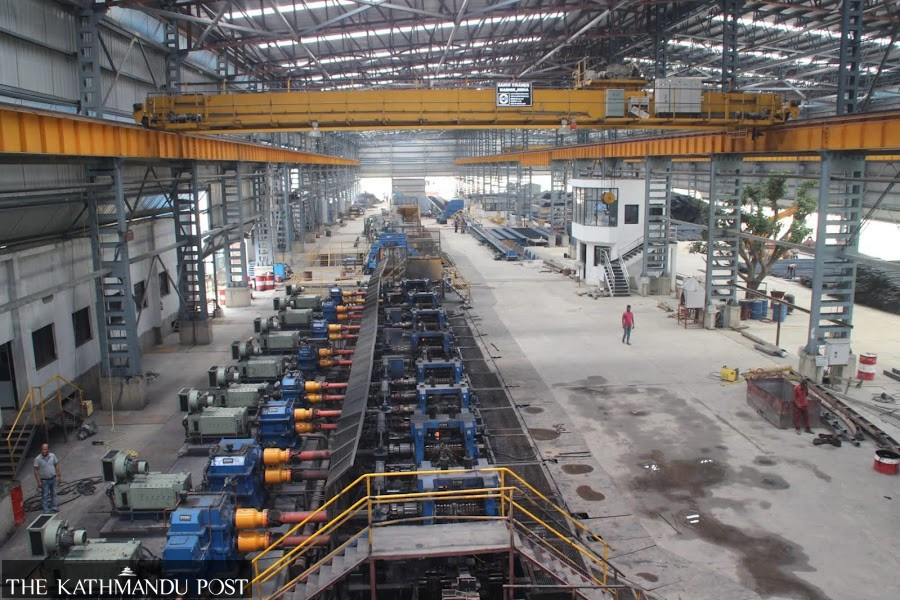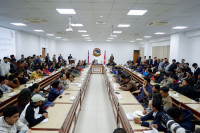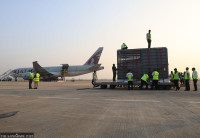National
Nepali manufacturing retarded by conflict, politics and energy crisis
The number of large manufacturing establishments grew by only 17.46 percent in 27 years, according to the National Industrial Survey.
Krishana Prasain
In the last three decades, only 746 large production plants were established in Nepal in a vivid reflection of how the decade-long Maoist insurgency, subsequent political instability and endless power cuts crippled the growth of the manufacturing sector, says a recent official report.
According to the National Industrial Survey 2019 unveiled by the Central Bureau of Statistics on Friday, the number of large manufacturing establishments grew by a meager 17.46 percent in 27 years.
Between the census years 1991-92 and 2018-19, the number of large plants in Nepal inched up from 4,271 to 5,017. The retarded growth in the manufacturing sector was one of the biggest push factors for Nepalis to choose foreign jobs, experts say.
The study shows that the number of large manufacturing establishments shrank to 3,557 in 1996-97, coinciding with the start of the Maoist conflict.
The figure fell further to 3,213 in 2001-02 when the royal massacre took place and the insurgency was at its peak.
Experts say the economy responded instantly to the Comprehensive Peace Accord signed between the government and the Maoist rebels in 2006, with the number of large factories increasing to 3,446 in 2006-07.
In 2011-12, there were 4,076 production plants in the country when the infamous load-shedding held back the country's manufacturing sector.
“It’s a very very slow growth,” said economist Puskar Bajracharya.
There were three reasons for the slow growth—high-cost economy, lack of adoption of modern technology and policy that was unfriendly towards investors.
"The private sector failed to introduce modern technology," Bajracharya said. “The government too ignored the need to encourage the private sector.” Moreover, the industrial policy was not conducive to boosting investment, he said.
“The industrial policies were highly encouraging when Nepal adopted a liberal economy in the early 1990s. This led to industrial growth but it has not prospered since then.”
The employment rate too has been stagnant over the years. The survey report shows that the manufacturing sector generated only 64,707 jobs in three decades.
The number of persons engaged in large-size manufacturing was 223,463 in 1991-92.
Employment in the manufacturing sector declined to 196,708 in 1996-1997.
It kept dropping over the next decade to 191,853 in 2001-02 and 177,550 in 2006-07. Things started looking up in 2011-12 with employment in the manufacturing sector inching up to 204,360.
It rose to 288,170 in 2018-19.

Dinesh Shrestha, vice-president of the Federation of Nepalese Chambers of Commerce and Industry (FNCCI), said political instability in the country crippled the manufacturing and industrial sectors.
“The political situation is still unpredictable. We don’t know what will happen next,” he said.
“Powerful business houses have a lot of influence at the policy-making level; and as a result, policies are made to benefit a certain group rather than to promote industrial development as a whole,” Shrestha said.
"The excise duty imposed on sponge iron is one example. There are many others,” he said.
"In the early 1990s, there was growth in large-scale manufacturing because of tax waiver provisions. The political system subsequently became so haphazard that there was no trust between the government and investors," Shrestha said.
“A huge investment is required to set up a large-scale industrial unit, and due to uncertain policy, investors do not take risks,” Shrestha said.
"Potential investors still find Nepal a risky place to invest. It is more difficult to exit the country than to enter. This shows how difficult it is to do business in the country.”
According to the survey report, the input cost of the large manufacturing sector, which was Rs20.94 billion in 1991-92, reached Rs625.72 billion in 2018-19. Input cost is the set of costs incurred to create a product or service.
The output cost, which was Rs33.09 billion in 1991-92, rose to Rs861.05 billion in 2018-19.
Output cost refers to the cost of product or services so as to decide the selling price as well as the total profitability from product or service along with a percentage of profit margin on the product or services, according to wallstreetmojo.com.
With a total of 15,871 factories, the food producing industry tops the list of manufacturing establishments, followed by apparels with 11,587 factories, the report showed.
The food manufacturing industry is one of the top 10 industries with value addition of Rs71.9 billion.
Nepali industry has been using only 38.5 percent of capacity mainly due to low market demand, competition from international products, inadequate raw materials, and insufficient resources and skilled manpower.
Considering bank loans, 60 percent of small manufacturing establishments have taken neither loans nor a line of credit while 45 percent of large manufacturing establishments have taken loans.
Agriculture, forestry and fishing are among the highest contributors to the gross domestic product at 23.95 percent. The manufacturing sector's contribution to the GDP is 5.65 percent.
The Central Bureau of Statistics said it collected data from 16,145 industrial firms to prepare the survey.
The manufacturing sector has the highest number of employees with 346,143 individuals.
The number of employees in electricity, gas, steam and air conditioning supply is 17,238.
There are 12,587 employees in water supply, sewage, waste management and remediation activities; and 5,719 employees in mining and quarrying.
These four industrial sectors make payments totalling Rs107.89 billion to their employees annually.
Payments in the manufacturing sector total Rs95.77 billion. Annual payments in electricity, gas, steam and air conditioning supply amount to Rs6.92 billion.
Payments in water supply, sewage, waste management and remediation activities amount to Rs3.40 billion. Payments in mining and quarrying amount to Rs1.80 billion.
Of the total input of Rs846.7 billion, the manufacturing sector has the highest input cost of Rs745.6 billion due to raw material price.
And of the total output cost of Rs1.2 trillion, the manufacturing sector has the highest output cost of Rs1 trillion, according to the survey.




 16.12°C Kathmandu
16.12°C Kathmandu















